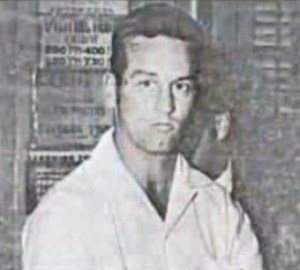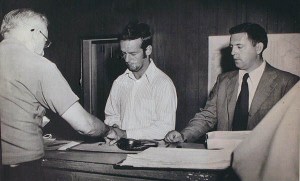
Shawcross was born in Kittery, Maine, the first of four children of Arthur Roy Shawcross and Elizabeth “Bessie” (“Betty”) Yerakes Shawcross. His family moved to Watertown in New York State when he was young. While several later tests showed Shawcross’ intelligence to be sub-normal or even “borderline retarded”, he received As and Bs in his first two years of grade school, but was later tested to have an I.Q. of 86, signifying below average intelligence. However, when tested in the army, Shawcross scored just above average in intelligence tests, scoring 105 upon entry and 108 at discharge. This was also the case with the intelligence tests he underwent while on trial in 1990, scoring 107.
Shawcross said throughout his childhood, he was a frequent bed-wetter. He later claimed his mother would insert foreign objects into his rectum, that his mother performed oral sex on him when he was 9, and that during junior high school he had sexual relations with his sister. Shawcross had a reputation at school as a bully and would frequently act out violently. He dropped out of high school in 1960.

In contrast to these claims, however, his parents and siblings maintain that he had a normal childhood, and the described events were largely the product of his imagination. There is no way of knowing whose version represents the reality of his upbringing, but what became clear, later on, was that Shawcross would change his stories at will, as he was interviewed by various professionals in the course of their investigations.
From school records it can be independently verified that he was an inveterate truant, with a particularly low IQ, a tendency to bullying and violence and that he came under suspicion for a series of juvenile arson attacks as well as burglaries. He dropped out of school after failing to pass the ninth grade, and the next few years were punctuated with violence and jail sentences. He received his first probationary sentence in December 1963 for smashing a shop window.

Shawcross married first wife, Sarah, in September 1964. The couple produced a son in October 1965. But another probationary charge for unlawful entry in November 1965, proved the last straw for his marriage and he was divorced soon after and gave up the rights to their 18-month-old son, whom he never saw again. In April 1967 he was drafted by the Army at age 21. He served one tour of duty in Vietnam, where he boasted of grotesque combat exploits, such as “beheading mama-sans and nailing their heads to trees as a warning to the Vietcong” – though in fact he never saw combat.
After Vietnam he was stationed at Fort Sill in Lawton, Oklahoma as an armorer. His second wife Linda experienced several aspects of his disturbing behaviour, especially his penchant for starting fires; an Army psychiatrist told her that Shawcross derived “sexual enjoyment” from fire starting. After his discharge from the Army, Shawcross moved with his wife from Oklahoma to Clayton, New York. His wife would soon divorce him, and he began committing crimes such as arson and burglary. His offenses earned him a five-year sentence at Attica Correctional Facility, and later Auburn Correctional Facility. After serving 22 months he was granted early release in October 1971, in part due to his role in the rescue of a prison guard during a riot.

Shawcross returned to Watertown, eventually getting a job with the Watertown Public Works Department. On April 22, 1972, he married his third wife, Penny Sherbino, who was pregnant with his child. On May 7, 1972, he raped and killed 10-year-old Jack Owen Blake, his first known victim, Shawcross took him fishing just a few days before he disappeared, but denied any knowledge of the disappearance. Five months later, his victim’s body was finally located. He had been sexually assaulted and suffocated, but police had no leads to the identity of the killer. Four months later, on September 2, he raped and killed eight-year-old Karen Ann Hill, who had been visiting Watertown with her mother for the Labor Day weekend.
In September 1972, the body of 8-year-old Karen Ann Hill was found under a bridge. She had been raped and murdered. Police found mud, leaves and other debris had been forced down her throat and inside her clothing. Neighbours remembered that Shawcross had been seen with Karen in the vicinity of the bridge before her disappearance, and he had a history of minor run-ins with local children. Shawcross came under immediate suspicion. Arrested in October, he confessed to both killings. Under the terms of a plea bargain he agreed to reveal the location of Blake’s body; in return he was permitted to plead guilty to a lesser charge of manslaughter in the Hill case, all other charges were dropped, and he received a 25-year sentence at Green Haven Correctional Facility. His third wife Penny divorced him shortly thereafter.

After twelve years, inexperienced prison staff and social workers concluded that Shawcross was “no longer dangerous”, disregarding the warnings of psychiatrists, who had assessed Shawcross as a “schizoid psychopath”. He was released on parole in April 1987. He had difficulty settling down in communities as the neighbours would protest his presence and employers would fire him. He first moved into Binghamton, New York, then relocated to Delhi, New York, with his girlfriend, Rose Marie Walley. When Delhi residents became aware of Shawcross’ presence, the couple moved to nearby Fleischmanns, New York, only to be met with hostility there as well.
His past meant that he would be unwelcome almost anywhere, and the authorities made the decision to seal his criminal record in order to prevent a recurrence of the public alarm in Binghamton. In late June 1987, Shawcross’ parole officer moved him and Walley into a transient hotel in Rochester, New York, but failed to notify Rochester authorities of this action. In mid-October Shawcross and Walley found more permanent lodgings at 241 Alexander Street in Rochester. When they moved Shawcross and Whalley to Rochester, New York, she became his fourth wife. In Rochester, Shawcross took on a succession of menial jobs. His lackluster marriage to Whalley meant that he was soon seeking solace elsewhere, both from prostitutes as well as his new girlfriend, Clara Neal.

It did not take long for Shawcross to return to his murderous ways. Hunters discovered his next victim, 27-year-old prostitute Dorothy Blackburn, on March 24, 1988. Her body was found in the Genesee River, dumped there following a vicious attack, which included bite marks in the groin area and strangulation. With little evidence, and no public impetus to solve the murder of a prostitute, her case languished for over a year. There were other murders of prostitutes in that time but, given the danger of the profession, nothing untoward was noticed that linked any of the cases.
The discovery of the body of another prostitute, Anna Steffen, on September 9, 1989, linked several of the victims. She died of asphyxia, and her body had been dumped in a similar manner to Blackburn’s corpse. Her body, however, was found far from the original murder scene, so again the possibility that a serial killer was at work was not recognized.

On October 21, 1989, the body of homeless woman Dorothy Keeler, aged 59, was discovered followed six days later by another prostitute, Patricia Ives, in the same area. Both had been asphyxiated and the press started to show an interest as the cases were linked. They nicknamed the offender “The Genesee River Killer.” In all the previous cases at least some attempt at concealment had been made, which police felt indicated previous criminal or military experience. They began to advise prostitutes working in the area to exercise caution, and sought as much information as possible about strangers operating in the area. They also began checking criminal records for offenders who might be living in the immediate area. Shawcross’ sealed criminal record meant that he shielded him from police scrutiny.
As prostitutes continued to disappear, it became apparent that the killer must be someone familiar to the women who worked in the area. Police were able to piece together a description of a regular client called “Mitch” or “Mike.” Women said this particular john was prone to violence. Then the body of 26-year-old June Stott, who was neither a prostitute nor drug user, was found on Thanksgiving Day. She had been strangled, anally mutilated after death, had her labia removed, and was gutted from throat to crotch like a wild animal.

With the body count mounting, the police sought assistance from FBI profilers. They divided the 11 unsolved prostitute murders into sub-groups according to method and position. They developed a profile that described the killer as a white male in his 20s or 30s, who was strong, probably with a previous criminal record, familiar with the area, and comfortable enough with the victims that they would enter his vehicle without question.
The lack of sexual interference indicated it might be someone with sexual dysfunction. The post-mortem injury inflicted on June Stott, and not on any other victim, indicated that the killer was becoming more comfortable around corpses, probably returning to the crime scene again later to relive the attack.

The discovery of the body of Elizabeth Gibson, on November 27, brought a breakthrough: suspect “Mitch” had been seen with her shortly before her disappearance, but they seemed no closer to establishing his identity. Police tried various tactics, including canvassing all the local bars, to no avail.
When a pair of discarded jeans was discovered near the river on December 31, 1989, containing an ID card for a girl named Felicia Stephens, police began an aerial search of the surrounding area. On January 2, 1990, a helicopter spotted what appeared to be a naked female body lying on the ice surface of the river by a bridge in the forest. The body was not Felicia Stephens but that of missing prostitute June Cicero. She had also been mutilated post-mortem, as well as sawn practically in half.

Even more importantly, the helicopter spotted a man standing on the bridge next to a small van. He appeared to be either masturbating or urinating. Fortunately for the authorities, Shawcross had, as speculated, returned to the scene of one of his crimes to relive the pleasure of the attack. Patrol teams on the ground were alerted to the vehicle, which had sped away. They finally tracked down Shawcross via the car’s registration, which was in the name of his girlfriend Clara Neal. When approached, Shawcross agreed to assist the police with their enquiries. When they asked for his driver’s license, he admitted he did not have one and then revealed that he had been in jail for manslaughter.
Police were confident they had their killer, and further questioning revealed the earlier child deaths and a grandiose account of his Vietnam War service, which was later discounted. A photo taken of him during the initial questioning soon confirmed his identity as “Mitch,” and official enquiries unearthed the reason for Shawcross’ sealed record, which prevented the police from tracking him down sooner. Still, police were unable to get Shawcross to admit to the murders — until they confirmed that a piece of jewellery he had given to Clara Neal previously belonged to victim June Cicero. When police threatened to implicate her in the killings, Shawcross capitulated and admitted to most of the murders, giving detailed excuses about why he had been “forced” to kill each one. He even admitted to the killing of two undiscovered bodies, those of prostitutes Maria Welsh and Darlene Trippi, leading investigators to their bodies. His formal confession was nearly 80 pages long.

All the victims were murdered in Monroe County, except for Elizabeth Gibson, who was killed in neighbouring Wayne County. The retired detective Robert Keppel has argued that the detectives investigating the case over-relied on the concept of modus operandi, at times searching for multiple suspects due to small differences in the profiles of each victim. In November 1990, Shawcross went on trial for the 10 murders that had occurred in Monroe County. The trial was a national media event, extensively televised and widely viewed. Shawcross’ defense team tried to build a case based on an insanity plea, citing various mitigating factors, such as his upbringing, post-traumatic stress as a result of military service, a cyst on the brain and a rare genetic defect.
From the time Shawcross returned from his tour of duty, he told acquaintances of seeing American soldiers “skinned from their neck to their ankles”, and claimed to have decapitated two women he had victimized, placing their heads on poles. FBI criminal profiler Robert K. Ressler reviewed the PTSD claim on behalf of the prosecution before the trial. Ressler wrote that “his claim of having witnessed wartime atrocities was patently outrageous and untrue.” Prosecution psychiatrist Dr. Park Dietz said Shawcross had antisocial personality disorder.

The prosecution was quick to dispute the claims about his childhood and military service, casting doubts on Shawcross’ testimony. The physiological evidence about brain science and genetic factors was, at best, spurious and beyond the understanding of the jury. It was also hindered by poor presentation on the part of the expert witnesses called to testify.
Shawcross was declared sane — and guilty of 10 instances of second-degree murder. The judge sentenced him to 25 years for each count, a total of 250 years imprisonment. A few months later, Shawcross was taken to Wayne County to be tried for Elizabeth Gibson’s murder. Rather than claim insanity this time, he pleaded guilty and received a further life sentence.

Shawcross was held at the Sullivan Correctional Facility in Fallsburg, New York, until he died on November 10, 2008 at the Albany Medical Center. In 2003, Shawcross was interviewed by British reporter Katherine English for a documentary on cannibalism. Shawcross bragged about slicing out and eating the vulvas of three victims, but refused to discuss his earlier claim of eating the genitals of his first victim, Jack Blake.
Officials said Shawcross complained of a pain in his leg on the afternoon of November 10, 2008, his date of death. He was taken to Albany Medical Center, where he went into cardiac arrest. Shawcross died at 9:50 p.m. He was cremated at a private crematorium.
